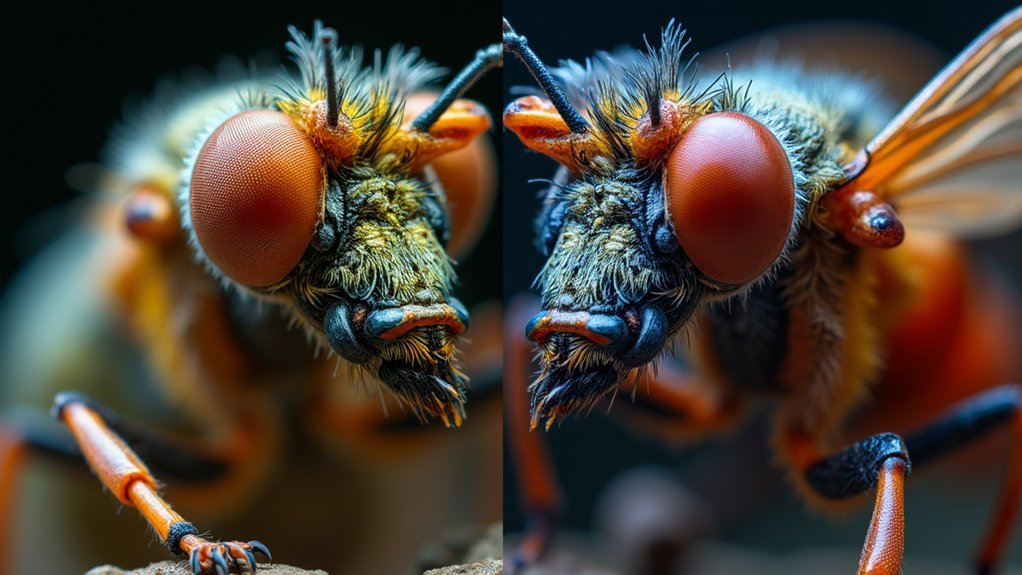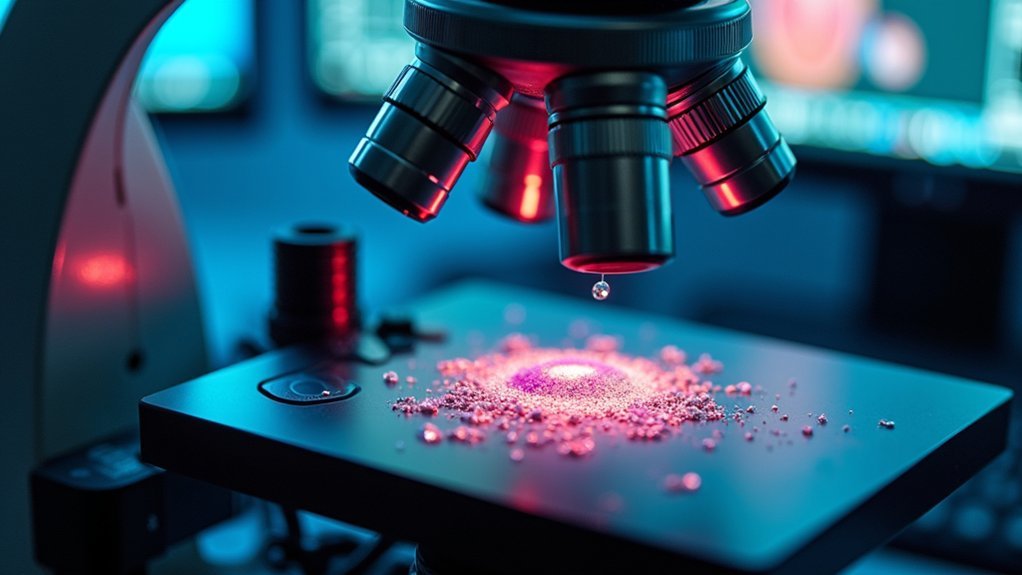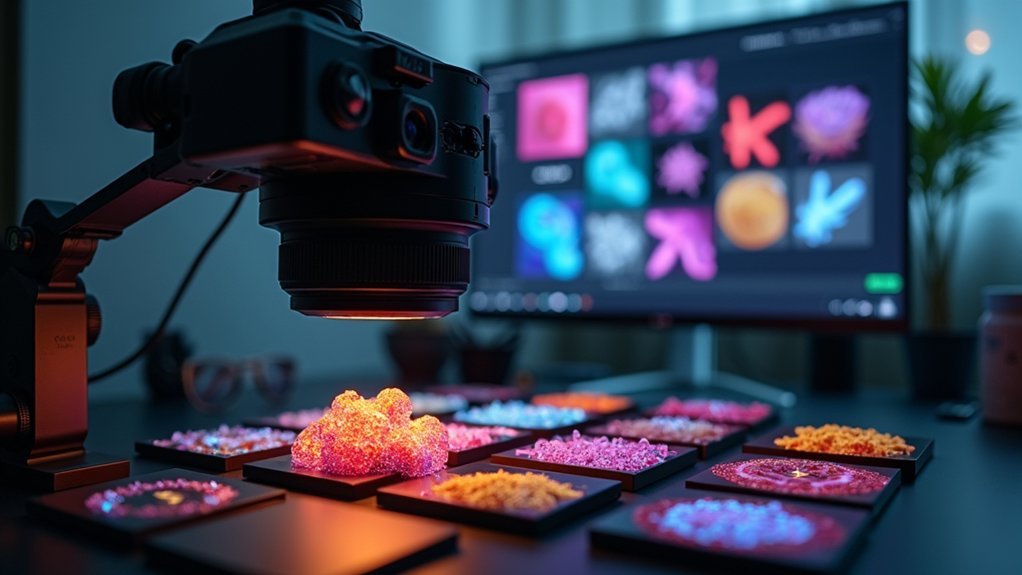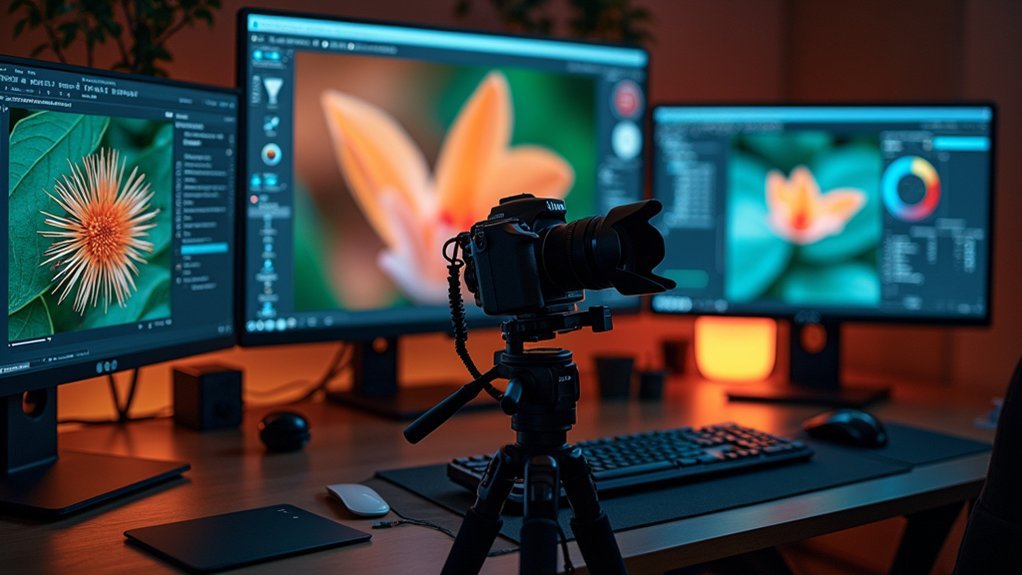For scientific photography, Zerene Stacker and Helicon Focus lead the field. Zerene offers superior retouching tools and reliability, while Helicon provides faster processing and microscope integration. Both support unlimited images, preserve metadata, and offer batch processing. For budget options, consider Zerene’s $39 student version or the free Focus-Stack (requires technical skill). Your choice depends on project complexity, needed precision, and whether speed or quality matters most. Proper hardware—16GB RAM minimum—will greatly impact your results.
Comparing Helicon Focus and Zerene Stacker: Performance and Quality

When choosing between the two leading focus stacking programs, you’ll need to weigh several key differences in performance and quality.
Helicon Focus excels with faster processing and produces focus stacked images with enhanced saturation and reduced noise. However, it’s been plagued by stability issues and lacks advanced retouching capabilities.
Faster processing with better color, yet undermined by crashes and limited touch-up tools.
Zerene Stacker, recognized as the industry standard for high quality, offers more control over contrast threshold during B-stacks despite its initially slower processing time.
Its reliability and excellent customer support make it the preferred choice for photographers prioritizing final image quality.
While both programs feature multiple stacking algorithm options and handle unlimited images, your decision may come down to whether you value Helicon’s speed and integration features or Zerene’s superior retouching tools and dependable performance.
Essential Features for Scientific Focus Stacking Programs
Scientific focus stacking programs must offer precision alignment capabilities that correctly register misaligned frames captured during microscopic or macro work.
You’ll need advanced artifact correction tools to eliminate halos, double edges, and other stacking imperfections that could compromise research integrity.
Data preservation controls should maintain original color profiles, metadata, and tonal ranges throughout the stacking process to guarantee scientific accuracy and reproducibility.
Precision Alignment Capabilities
Because images must be perfectly registered to create crisp composite photographs, precision alignment capabilities stand as a cornerstone feature in scientific focus stacking software.
When you’re working with high-magnification macro photography, even microscopic misalignments can ruin your results.
Both Helicon Focus and Zerene Stacker excel in this area, offering advanced algorithms that handle unlimited images while maintaining precise registration.
Zerene Stacker provides extensive control over alignment parameters, allowing you to compensate for camera movement or subject shifts.
Meanwhile, Helicon Focus integrates with Helicon Remote for additional precision and includes panorama stitching capabilities.
You’ll find multiple stacking algorithms in both programs – from depth map to data pyramid methods – ensuring ideal alignment and blending for high-quality outputs in scientific applications where accuracy can’t be compromised.
Advanced Artifact Correction
Even the most sophisticated focus stacking algorithms can introduce unwanted visual anomalies, making advanced artifact correction tools vital for scientific photography applications. When evaluating focus stacking software, you’ll want to prioritize programs with robust retouching tools.
| Software | Artifact Correction Features | Algorithm Benefits | Integration |
|---|---|---|---|
| Zerene Stacker | Robust manual retouching tools | Minimal human intervention | Sub-stack editing |
| Helicon Focus | Adjustable radius and smoothing sliders | Method A preserves color profiles | External editor support |
| Photoshop | Final cleanup capabilities | – | Works with both programs |
| Combined Workflow | Targeted corrections | Multiple algorithms reduce artifacts | Enhanced scientific accuracy |
For best results, you’ll benefit from Helicon’s adjustable parameters for complex stacks while Zerene’s sub-stack functionality allows for targeted corrections—both essential for maintaining scientific integrity in your photographic documentation.
Data Preservation Controls
When conducting precision photography for research purposes, preserving the original data integrity throughout the focus stacking process is non-negotiable.
Both Helicon Focus and Zerene Stacker offer robust data preservation controls that guarantee your scientific documentation maintains accurate representation without sacrificing image quality.
- Helicon’s DNG file support preserves raw data and metadata, giving you confidence that critical information remains intact for analysis.
- Zerene Stacker’s customizable blending parameters let you fine-tune the stacking process while minimizing information loss.
- Both programs support batch processing workflows that maintain original color profiles and data attributes across multiple datasets.
You’ll appreciate these features when publishing research where data integrity is scrutinized.
The ability to retouch artifacts while retaining original image data makes these focus stacking programs essential tools for scientific photography.
Open-Source Alternatives: Focus-Stack and Other Free Solutions
Focus-stack offers impressive image quality without the price tag of commercial alternatives, making it an excellent option if you’re comfortable with command-line operations.
You’ll need to organize your images properly and execute commands from the appropriate terminal location, but the results rival those of paid software despite longer processing times.
Despite its technical learning curve, you’ll find helpful community support and documentation to guide you through command syntax and troubleshooting as you master this powerful free stacking solution.
Command-Line Powerhouse: Focus-Stack
Though lacking a graphical interface, the open-source Focus-stack program offers photographers a powerful alternative to expensive commercial options.
You’ll execute commands like `focus-stack.exe *.JPG –output myoutput.png` to automate the stacking process for multiple images while preserving original resolution.
Despite its command-line nature, the image quality rivals paid solutions, with comparable file sizes.
- Process entire folders of images in batches, saving significant time over manual stacking methods
- Retain complete control over output formats, with PNGs (60MB) or JPGs (9.47MB) available depending on your quality needs
- Access community support and documentation to help navigate the command syntax and optimize your workflow
If you’re comfortable with basic terminal operations, this GitHub-hosted tool delivers professional results without the premium price tag.
Free Quality Without Compromise
Several high-quality open-source alternatives exist for photographers unwilling to compromise on image quality but wanting to avoid expensive software. Focus-stack stands out as a powerful command-line tool that delivers professional results without the price tag.
| Feature | Focus-stack | Commercial Options |
|---|---|---|
| Cost | Free | Often expensive |
| Quality | High-quality PNG files (60MB) | Similar quality |
| Learning Curve | Requires command-line knowledge | More intuitive interfaces |
When using focus-stack, you’ll maintain your original resolution throughout the focus stacking process while enjoying the flexibility of batch processing through scripting. Though processing times may exceed commercial alternatives, the community support and thorough documentation make the initial setup manageable even for beginners. For photographers on a budget, this GitHub-available solution provides impressive capabilities without financial compromise.
Workflow Integration: Compatibility With Microscopy Equipment

Microscopic imaging presents unique challenges where every detail matters, making focus stacking software an invaluable tool in scientific photography. Leading programs like Helicon Focus and Zerene Stacker integrate seamlessly with microscopy equipment, enhancing your depth of field while maintaining exceptional clarity in high-resolution images.
- Helicon Remote allows you to control compatible microscopes directly from your computer, creating precision-focused image sequences without touching sensitive equipment.
- Both Zerene Stacker and Helicon Focus support scientific file formats like DNG and TIFF, ensuring compatibility with images captured at high magnifications.
- Advanced alignment algorithms automatically correct positioning variances between frames—critical when working at microscopic scales where even minor vibrations can affect results.
When selecting focus stacking software for your scientific work, prioritize options that offer fine control over stacking parameters and efficient workflow automation.
Advanced Retouching Tools for Specimen Documentation
While capturing the stack is just the beginning of your workflow, the advanced retouching capabilities in modern focus stacking programs truly set them apart for scientific specimen documentation. Both Zerene Stacker and Helicon Focus offer sophisticated tools that allow you to refine composite images with precision.
| Software | Retouching Feature | Benefits for Specimen Documentation |
|---|---|---|
| Zerene Stacker | Customizable workflows | Fine-tuning of stacking artifacts |
| Helicon Focus | Retouching tab | Refinement of complex stacked areas |
| Zerene Stacker | Synthetic stereo pairs | Enhanced 3D representation |
| Helicon Focus | Detail retention | Accurate specimen representation |
| Both | Photoshop integration | Final cleanup for maximum clarity |
You’ll appreciate how these focus stacking software options preserve critical scientific details while enabling creative presentation through 3D animations and stereo pairs—essential for thorough scientific photography documentation.
Batch Processing Capabilities for High-Volume Research

When research projects demand processing hundreds or thousands of specimen images, efficient batch processing capabilities become indispensable. Both Helicon Focus and Zerene Stacker excel in this area, allowing you to merge multiple image stacks simultaneously while maintaining consistent parameters across all datasets.
- Save hours of manual processing time by automating repetitive stacking tasks
- Process unlimited images in a single operation, perfect for extensive scientific photography projects
- Utilize command-line interfaces (like in Focus-stack) for scripted workflows in laboratory settings
These batch processing features dramatically improve time efficiency in scientific photography workflows. You’ll spend less time on image preparation and more on analyzing your research findings.
For high-volume research environments where every minute counts, these automated capabilities prove invaluable to maintaining productivity.
Cost-Benefit Analysis of Premium vs. Free Stacking Software
The investment decision between premium and free focus stacking software represents a critical crossroad for photographers and researchers alike.
Premium solutions like Zerene Stacker ($55-$289) and Helicon Focus ($30/year or $115 lifetime) deliver superior image quality and thorough support that justify their cost for professionals requiring consistent results.
When conducting your cost-benefit analysis, consider that free options like Focus-stack require technical skills but eliminate financial investment.
If you’re budget-conscious but need quality, Zerene’s student version at $39 offers an excellent middle ground.
Your decision should ultimately balance several factors: project complexity, technical expertise, and output requirements.
While premium software provides refined interfaces and advanced features, free alternatives may suffice for occasional use—though they’ll demand more time and technical knowledge to achieve comparable results.
Technical Requirements and System Optimization for Stacking Efficiency

Beyond software selection, your hardware configuration and system setup will determine how efficiently you process focus stacks. For peak performance when running focus stacking software, you’ll need adequate computer processing power—faster CPUs dramatically reduce processing time when blending multiple high-resolution images.
- Ascertain you have sufficient RAM (16GB minimum) to handle large files, especially if you’re working with RAW or TIFF formats from high-resolution cameras.
- Maintain organized image files in appropriate formats to prevent compatibility issues and streamline your workflow.
- Implement system optimization techniques like disabling background applications and utilizing dedicated graphics cards to maximize processing efficiency.
Cameras with focus-shift functionality will also streamline your capture process, allowing you to collect consistent focal point series without manual adjustments between shots.
Frequently Asked Questions
What Is the Best Software for Focus Stacking?
For focus stacking, Zerene Stacker is your best choice if you need superior image quality and reliability, while Helicon Focus works well if you’re prioritizing speed and simpler operations at a lower price.
Is Helicon Focus Worth It?
Helicon Focus is worth it if you’re a serious photographer needing quick, high-quality stacks. You’ll get saturated images with less noise, though you’ll face some stability issues and may still need Photoshop for final edits.
How Much Does Helicon Focus Cost?
Helicon Focus costs $55 yearly or $200 for a permanent license. You’ll pay $30 yearly or $115 lifetime for the Lite version. There’s a 30-day free trial with full functionality.
What Is the Best App to Stack Photos?
For photo stacking, your best option depends on your needs. Zerene Stacker is the industry standard with powerful retouching tools, while Helicon Focus offers user-friendly operation. ON1 Photo Raw works well for simpler projects.
In Summary
You’ll find that premium programs like Helicon Focus and Zerene Stacker deliver superior results for scientific photography, but don’t dismiss open-source alternatives for basic needs. Consider your workflow requirements, specimen complexity, and volume of images when making your choice. Ultimately, the best focus stacking program is one that integrates seamlessly with your equipment while producing the artifact-free, detailed images your research demands.





Leave a Reply